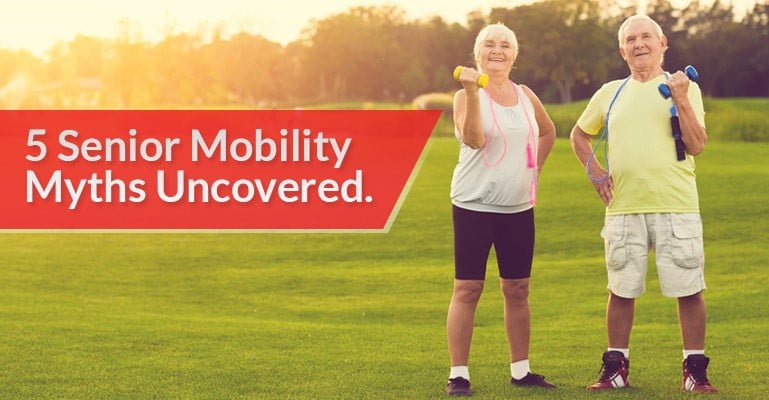The image of grandma sitting in her wheelchair watching Wheel of Fortune is a classic, albeit misinformed, portrait of the American senior citizen. Mobility problems might keep some seniors from running marathons, but they certainly don’t have to keep them from living healthy and purposeful lives. Is your mobility know-how up to speed? Check out what we’ve uncovered about the top 5 senior mobility myths:
Mobility isn’t a Problem If I Can Still Walk
FALSE: Knowing the signs of mobility issues early on can be hugely beneficial in the long run. Even if you or your loved one can still get up and move around with relative ease, there may be other indicators of mobility problems that require medical attention:
- Tiring easily or feeling winded after standing or walking for more than 10 minutes
- Pain or discomfort when standing or walking
- The trouble with balance and coordination (including multiple falls)
- Avoidance bearing weight on a specific leg
If any of these sound familiar, talk with your doctor about your mobility and any treatment, therapy, or mobility aids that might be helpful in keeping you or your loved one moving.
Doctor’s Visits: Why Checkups Are Vital
You Should Avoid Exercise
FALSE: While maintaining physical fitness can be scary for seniors, especially those with mobility issues or those who have experienced a fall before, exercise is still vital to overall physical and mental health. Regular exercise through low-impact activities like walking, yoga, swimming, dancing, or even mowing the lawn provides enough aerobic activity to keep the heart and lungs strong, build bone mass, burn calories, and boost blood circulation.
For seniors with mobility issues, this type of exercise is even more important in helping combat obesity, diabetes, hypertension, heart disease, and even dementia and Alzheimer’s. If you or your loved one are wheelchair-limited, walking or running might not be possible. Instead try relaxing and restorative chair yoga that can be done sitting down, or seated aerobic stretching and light weightlifting that gets the heart pumping and promotes strength and flexibility.
Using a Mobility Aid Will Make Me More Dependent
FALSE: While relying completely on a mobility aid and avoiding activity can have negative consequences for your health, mobility aids are actually designed to empower and promote independence. It’s in the name – of mobility “aid.” Canes, walkers, wheelchairs, etc. are designed to get you where you need to go, but also help to keep you moving and active.
Advancements in assistive mobility technology have introduced enhanced mobility aids with even more maneuverability, like rental knee scooters. Instead of hobbling around on crutches or resigning yourself to a wheelchair while recovering from a foot or leg injury, for example, knee scooters can provide a stable and efficient way for you to move around with ease. Mobility aids also include chair and bath lifts which simplify the processes of getting up and down the stairs or in and out of the bathtub. These types of devices help you remain self-reliant as you age.
Falls Don’t Typically Happen at Home
FALSE: Over half of all seniors who experience a fall do so in their own homes. Falls put seniors at major risk for broken bones, lacerations, bruising, and hospitalization – all of which can substantially inhibit mobility and lead to long recovery periods. Prevent falls at home with a handful of simple reminders:
- Remove clutter and trip hazards from walkways, like old carpets with turned-up corners or jumbled extension cords
- Have your eyes checked regularly to ensure your vision is at its best for getting around safely
- Add grab bars and reflective guide tape to tricky environments like stairways and bathtubs to make them easier to see and traverse
- Wear properly fitting shoes that provide stability and traction
Bone Density and Muscle Strength Can’t Be Regained
FALSE: The notion that mobility issues signify “it’s all downhill from here” is an unnecessary one. Depending on your condition, regaining full mobility may not be possible; but reversing bone damage and strengthening muscles is absolutely still achievable.
With a healthy diet, proper hydration, and regular exercise, seniors can regain lost muscle mass, including strengthening the heart (which stimulates healthy blood pressure and fights heart disease), as well as increasing bone density and reducing the risk of osteoporosis. Maximizing one’s physical capabilities also facilitates greater flexibility, balance, and coordination, which help to prevent falls and promote regular exercise. Fibromyalgia: What Are Your Best Options For Treatment?
Mobility problems can be a real blow to the self-confidence of seniors. Understanding the myths about mobility and knowing that life doesn’t have to come to a halt just because you need a little assistance getting around is key to staying motivated. With the right mobility aid, regular exercise, and proactive measures for fall prevention, seniors with mobility issues can live the best lives possible.
However, if there is any emergency or you need immediate assistance, do not forget to visit your nearest urgent care medical center.



